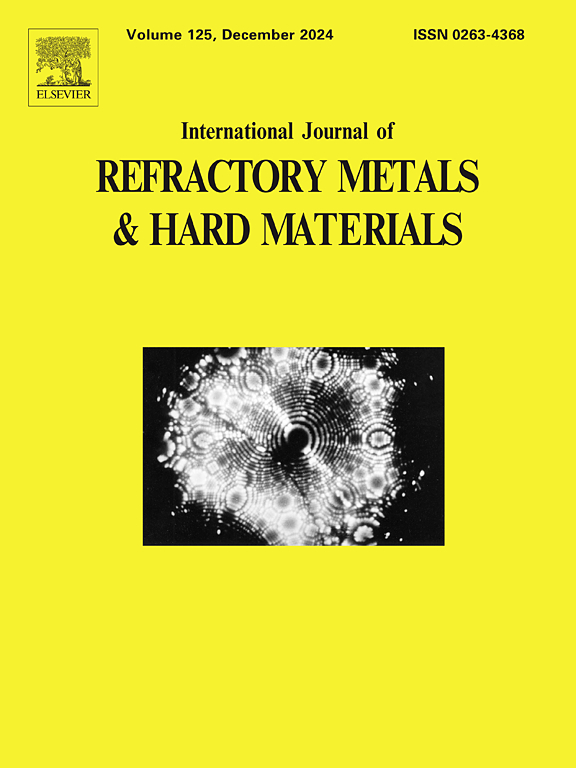Void formation driven by plastic strain partitioning during creep deformation of WC-Co
IF 4.2
2区 材料科学
Q2 MATERIALS SCIENCE, MULTIDISCIPLINARY
International Journal of Refractory Metals & Hard Materials
Pub Date : 2024-11-02
DOI:10.1016/j.ijrmhm.2024.106950
引用次数: 0
Abstract
Creep deformation of WC-Co composites at high temperature and stress is accommodated by either bulk WC creep or by Co-infiltrated grain boundary sliding. It has been proposed that certain grain boundaries are more susceptible than others to such sliding, and depending on the applied stress, the overall deformation rate can be limited by either mechanism. Here, we have used Electron Back-Scatter Diffraction to study the strain partitioning in each phase, the evolution in phase boundary and grain boundary misorientation, and void formation. Several WC-Co samples (Co contents ranging 7–13 % and grain sizes 0.5–1 μm) were deformed by unconstrained compression at 1000 °C under constant load in the range 0.5–1 GPa. The localised deformation state – as characterised by increases in pixel misorientation and inverse pole figure dispersion – increased significantly between 0.5 and 0.75 GPa for both phases, which may be associated with the onset of grain boundary sliding. The onset of the formation of creep voids occurred when the stress level was 0.75 GPa or more. Deformation was correlated with an increase in 60° CoFCC /CoFCC boundaries, and in 56° WC/CoFCC boundaries. Boundaries with the latter misorientation angle may preferentially enable the Co infiltration process.
WC-Co 蠕变变形过程中塑性应变分配驱动的空洞形成
WC-Co 复合材料在高温和应力条件下的蠕变变形是通过块状 WC 蠕变或 Co-infiltrated 晶界滑动来实现的。有人提出,某些晶界比其他晶界更容易受到这种滑动的影响,而且根据所施加的应力,两种机制都会限制整体变形率。在此,我们使用电子反向散射衍射法研究了各相的应变分配、相界和晶界错向的演变以及空洞的形成。在 1000 °C、0.5-1 GPa 的恒定载荷条件下,对几种 WC-Co 样品(钴含量为 7-13%,晶粒大小为 0.5-1 μm)进行了无约束压缩变形。在 0.5 至 0.75 GPa 的范围内,两种相的局部变形状态(表现为像素错向和反极点分布的增加)显著增加,这可能与晶界滑动的开始有关。当应力水平达到或超过 0.75 GPa 时,开始形成蠕变空洞。变形与 60° CoFCC /CoFCC 边界和 56° WC/CoFCC 边界的增加有关。具有后一种错向角的边界可能更有利于钴的渗透过程。
本文章由计算机程序翻译,如有差异,请以英文原文为准。
求助全文
约1分钟内获得全文
求助全文
来源期刊
CiteScore
7.00
自引率
13.90%
发文量
236
审稿时长
35 days
期刊介绍:
The International Journal of Refractory Metals and Hard Materials (IJRMHM) publishes original research articles concerned with all aspects of refractory metals and hard materials. Refractory metals are defined as metals with melting points higher than 1800 °C. These are tungsten, molybdenum, chromium, tantalum, niobium, hafnium, and rhenium, as well as many compounds and alloys based thereupon. Hard materials that are included in the scope of this journal are defined as materials with hardness values higher than 1000 kg/mm2, primarily intended for applications as manufacturing tools or wear resistant components in mechanical systems. Thus they encompass carbides, nitrides and borides of metals, and related compounds. A special focus of this journal is put on the family of hardmetals, which is also known as cemented tungsten carbide, and cermets which are based on titanium carbide and carbonitrides with or without a metal binder. Ceramics and superhard materials including diamond and cubic boron nitride may also be accepted provided the subject material is presented as hard materials as defined above.

 求助内容:
求助内容: 应助结果提醒方式:
应助结果提醒方式:


